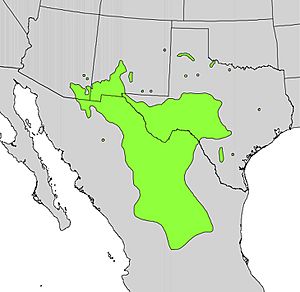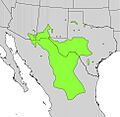Littleleaf sumac facts for kids
Quick facts for kids Rhus microphyllaLittleleaf sumac |
|
|---|---|
 |
|
| Rhus microphylla fruit | |
| Scientific classification | |
| Genus: |
Rhus
|
| Species: |
microphylla
|
 |
|
| Natural range of Rhus microphylla | |
The littleleaf sumac, also known as Rhus microphylla, is a type of sumac plant. It is a small shrub or tree that belongs to the Anacardiaceae family, which also includes plants like cashews and pistachios. This plant is native to North America, growing in the dry regions of the southwestern United States and northern and central Mexico.
Contents
Discover the Littleleaf Sumac
The littleleaf sumac is a hardy plant that can grow in tough, dry places. It is known for its small leaves and clusters of tiny fruits. These fruits are often a bright red or orange color, making the plant easy to spot in its natural habitat. The plant can grow up to 10 feet (3 meters) tall, but it often appears as a smaller, bushy shrub.
What Does It Look Like?
This sumac has many branches that spread out. Its leaves are very small, which is how it gets the name "microphylla" – "micro" means small, and "phylla" means leaf. Each leaf is made up of several tiny leaflets. In the spring, the littleleaf sumac produces small, yellowish-white flowers. These flowers grow in clusters at the ends of the branches.
The Fruit of the Sumac
After the flowers bloom, they turn into small, round fruits. These fruits are often covered in tiny, soft hairs. They are usually bright red or reddish-orange when they are ripe. The fruits are a food source for many birds and other small animals in the desert.
Where Littleleaf Sumac Grows
The littleleaf sumac is well-adapted to dry, desert-like conditions. It is found in parts of the United States and Mexico.
Its Natural Home
In the United States, you can find this sumac in central and western Texas, southern New Mexico, and extreme southeastern Arizona. It often grows in rocky areas, along dry riverbeds, or on hillsides. In Mexico, it is common in the northern and central parts of the Mexican Altiplano, also known as the Mexican Plateau. This plant thrives in sunny spots with well-drained soil.
Adapting to Dry Climates
Because it lives in dry areas, the littleleaf sumac has special ways to survive. Its small leaves help it save water, as less surface area means less water loss. Its deep roots can reach water far underground, helping it to stay alive during long dry spells.
Uses and Importance
Like many plants, the littleleaf sumac has been useful to both people and animals for a long time.
Food and Drink
Native American tribes in the regions where this sumac grows have traditionally used its fruits. The tart, sour fruits can be used to make a refreshing drink, similar to lemonade. They can also be dried and ground into a powder to add flavor to food. The taste is often described as tangy or lemony.
Wildlife Benefits
The fruits of the littleleaf sumac are an important food source for many types of wildlife. Birds, such as quail and thrashers, eat the berries. Small mammals also feed on the fruits, helping to spread the plant's seeds to new areas. The plant also provides shelter for small animals in its dense branches.
Life Cycle of the Littleleaf Sumac
The littleleaf sumac goes through a typical plant life cycle, adapting to its dry environment.
From Seed to Shrub
The life of a littleleaf sumac begins as a seed, often spread by animals that eat its fruit. Once a seed lands in a suitable spot with enough moisture, it will sprout. The young plant grows slowly at first, focusing on developing a strong root system to find water. As it matures, it grows into a shrub or small tree.
Flowering and Fruiting
In the spring, usually from April to June, the mature sumac produces its small flowers. These flowers are pollinated, often by insects. After pollination, the plant develops its distinctive red fruits. These fruits ripen in late summer and fall, ready to be eaten by animals and spread new seeds. The plant can live for many years, continuing to produce flowers and fruits each season.
Images for kids
See also
 In Spanish: Rhus microphylla para niños
In Spanish: Rhus microphylla para niños



